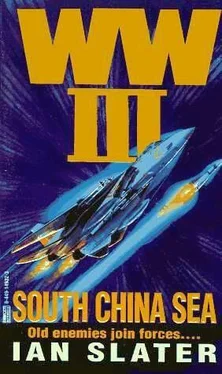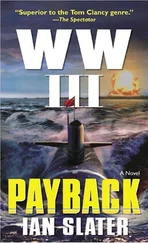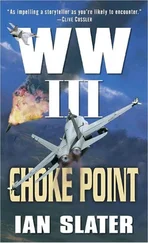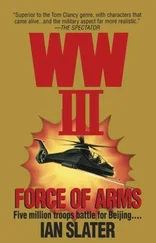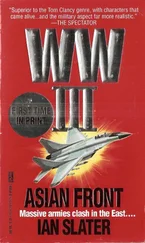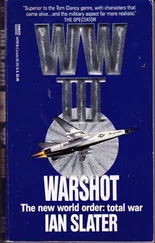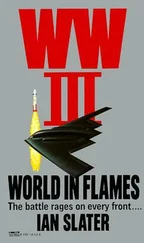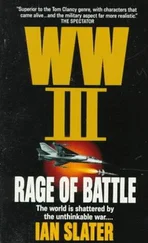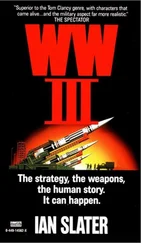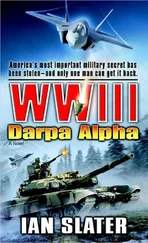The indoctrination session ended with several militiamen dozing off, the general belief being that there would be no further Chinese breakthrough, that their Vietnamese regular army would soon counterattack and with the help of American bombers force the Chinese back from the Lang Son line across the border.
* * *
The arrival of the EMREF recon spearhead was known to Beijing within half an hour of the Hercules landing, CNN having beaten the transmissions of Chinese Vietnamese agents who radioed the news to the Chinese capital. But CNN, as part of its “deal” with Freeman, hadn’t disclosed it was only one Hercules, and had it not been for the agents’ transmissions, Beijing would have been under the impression that the total EMREF force of several thousand had already arrived in Hanoi.
In any event, the news jolted Beijing, and within minutes the HQs of the Chengdu and Guangzhou military regions had been notified that the gains made so far by Generals Wei and Wang must be consolidated as soon as possible on both flanks of the Lang Son front— before the American genius for logistical buildup could be exercised.
“It is like,” General Wei’s cadres explained to his troops, “attacking a loaded bullock cart — kill the bullock driver first before he can unload his weapons and ammunition.” In this instance, Wei explained to his HQ personnel, the carts — the U.S. air supply line — might not be stopped by the Chinese air force, but the lead driver, Freeman, was already here and could be killed.
The Chinese general announced that any PLA unit wiping out Freeman’s advance spearhead would receive a “thousand commendations from the people.” This phrase was officialese for the fact that any unit that wiped out Freeman’s spearhead force would receive a monetary reward — one thousand dollars U.S. It was a small fortune, and on the black market it would buy many American cigarettes. Some senior cadres objected that this was unworthy of the people’s army ideology and was a “capitalist corruption” of the troops, to which Generals Wei and Wang responded that they were responsible for the military tactics and that the cadres, with all due respect, should keep out of it — it was a military not a political matter. A senior cadre continued to object, and Wei told him in very unpolitical terms to perform a sexual act on himself with a pointed stick.
A thousand feet below the surface of the South China Sea aboard Santa Fe, a sonar analysis confirmed the earlier Sea King’s contact as a “Sierra Four,” or probable enemy surface vessel.
“Possible hostile by nature of sound, bearing one four six! Range eighteen miles!”
“Very well,” the captain said calmly, already at the control room’s attack island. “Man battle stations.”
“Man battle stations, aye, sir,” a seaman of the watch repeated, pushing the “yellow” button that sent a pulsing F sharp slurring to G throughout the ship.
The captain turned to the D.O. “Diving officer, periscope depth.”
“Periscope depth, aye, sir.”
The captain quickly, quietly, took the PA mike from its cradle. “This is the captain. I have the con. Commander Rogers retains the deck. Up search scope.”
“Ahead two-thirds.”
“Scope’s breaking,” reported one of the watchmen. “Scope’s clear.”
The captain and the search scope’s column became one, moving about, looking for a dot on the flat metallic-colored sea.
Now the sub’s sonar had picked up the cavitation, or sound of water bubbles caused by the turning propeller of the unknown ship. At first it was suspected that it might be one of the destroyers of the carrier battle group, but within seconds the noise, having passed through the acoustic spectrum analyzer, suggested the craft was either a fast 32-knot Luda-class destroyer or a Jianghu-class frigate. In any case, her speed was now 23 knots, the details on the computer screen quickly giving the two classes’ dimensions and armament, both equipped with antisubmarine depth charges, surface-to-surface HY2 missiles and mines. The ship was now on a heading not for the Santa Fe, whose presence she had probably not detected, but in the direction of the Enterprise carrier battle group, an enemy mission that clearly fell under the Santa Fe rules of engagement and within the parameters of the sub’s mission orders to protect the CVBG.
“Make the tube ready in all respects,” the captain ordered.
“Make the tube ready in all respects, aye, sir.”
The Luda class had now increased her speed to 25 knots.
The sub’s captain stopped moving the scope. “Bearing. Mark!”
“Range. Mark! Down scope!” He heard the soft whine of the retracting M-18 search scope equipped with infrared. “I hold one visual contact. Range?”
“Seventeen point two miles.” On the green “waterfall” of the display screen the target’s sound was represented by a vertical white line. Forward in the torpedo room, 650 pounds of explosive in the nose of a Mark 48 advanced-capability torpedo, equipped with twenty miles of control wire — capable of 67 knots and a range of twenty-five-plus miles, and known by Santa Fe’s crew as “heavy freight”—was loaded and ready in number 7 tube on the port side.
“Range?” asked the captain.
“Seventeen miles — decreasing.” Every man on the boat went about his business with a deft, quiet approach to everything, including the placing of the compacted garbage container into a freezer. Any ejection of it could immediately have signaled the sub’s position to the enemy, and the captain did not know if the Chinese ship was alone. There could be another one lying silent, its cavitation not yet picked up by Santa Fe’s passive sonar.
“Torpedo in port tube one, sir.”
“Very well. Angle on the bow,” the captain said. “Port, three point five.”
“Check,” came the confirmation.
“Range?” the captain asked.
“Sixteen point seven miles.”
“Sixteen point seven miles,” the captain repeated. “Firing point procedures. Master four five. Tube one.”
“Firing point procedures, aye, sir. Master four five. Tube one, aye.. solution ready… weapon ready… ship ready…”
“Match bearings and shoot.”
The Mark 48’s ram jet shot the torpedo into the sea. At 65 knots, given the varying salinity of the water and the relative speed of the two ships, it would take the torpedo plus or minus fifteen minutes to reach the target.
* * *
Now, in the predawn darkness, the Vietnamese welcome seemed as if it had never happened. Gone were the lines of villagers, whether sent out by the Hanoi government or not, and in their stead there were only the flitting images of the night, a constant stream of misbegotten shapes that, with a little fear and imagination, could be anything and everything, from a Chinese T-59 tank to a squad of PLA moving up ready to fire. But except for the noises of the aging trucks, it was a quiet ride for the EMREF spearhead for whom the only indication of battle was the occasional thump of distant artillery from the direction of Lang Son.
“This is far enough,” Vinh’s interpreter told Freeman, who quickly alighted from his Humvee, the first two vehicles in the following ten-truck convoy also slowing to a stop. Tail boards were lowered rather than dropped, as quietly as possible, and now what was called the “great humping” began, as each soldier prepared to “saddle up” for the reconnaissance patrol to probe the Lang Son line.
General Vinh’s intelligence reports, as good as they might be, hadn’t provided Freeman with enough information for any confident and immediate deployment of Second Army once it arrived. And as Freeman told Robert Cline, he couldn’t afford a mistake because of something lost in what the interpreter might or might not say. He had to find out for himself, and so eighteen miles northeast of Hanoi, just before the town of Ba Ninh, the 127-member spearhead of the EMREF task force company split into four platoons of thirty men each. Freeman’s intention was to proceed toward the Lang Son front in clover-leaf pattern, seven-man patrols from each company constantly moving out on the flanks, circling to prevent ambush as the whole company of four platoons, one behind the other, moved forward. A five-man radio and rifle squad remained with the trucks already helping the Vietnamese drivers and guards to camouflage the vehicles, mainly against the possibility of Chinese recon planes from the border area seventy-eight miles away, beyond Lang Son.
Читать дальше
